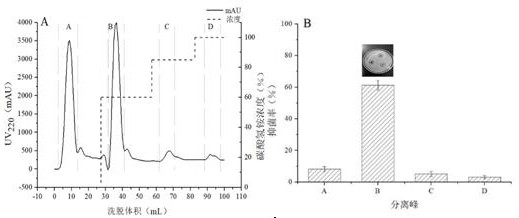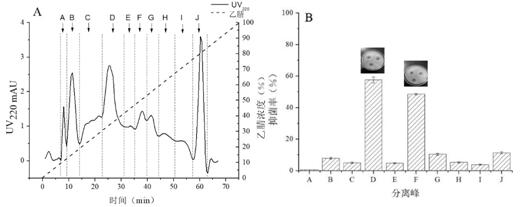A method for Bacillus amyloliquefaciens to produce antibacterial active substances
A technology of amylolytic spores and antibacterial activity, applied in the field of microorganisms, can solve the problems of insufficient research on the mechanism of action of antibacterial substances, complex components of antibacterial substances, and low content
- Summary
- Abstract
- Description
- Claims
- Application Information
AI Technical Summary
Problems solved by technology
Method used
Image
Examples
Embodiment 1
[0042] Bacillus amyloliquefaciens was cultivated with fermentation medium, and the supernatant was acid-precipitated and organic solvent extracted for DEAE anion exchange chromatography, column: DEAE-Sepharose-Fast Flow anion chromatography column, mobile phase A: 20 mmol / L, pH 8 Tris-HCl buffer, mobile phase B: 1 mol / L NH 4 HCO 3 Tris-HCl buffer solution, injection volume: 5 mL, detection wavelength: 220 nm. After elution with 3 column volumes of buffer A, gradient elution was performed with mobile phase B at concentrations of 0%, 60%, 80%, and 100%. Using Staphylococcus aureus as the indicator bacteria, the modified Oxford cup method was used to measure the antibacterial activity of the separated peaks, and the results were as follows: figure 1 The results showed that the elution peak B detected the bacteriostatic zone, the measured bacteriostatic diameter was (19.2±0.3) mm, and the calculated bacteriostatic rate was 61.25%.
Embodiment 2
[0044] RP-HPLC separation was performed on the isolated peak B. Chromatographic conditions: Waters XBridge Prep C18 column (10×250 mm, 5 μm), mobile phase A: acetonitrile containing 0.1% TFA, mobile phase B: ultrapure water containing 0.1% TFA, flow rate: 0.5 mL / min, detection Wavelength: 220 nm, injection volume: 0.5 mL. Equilibrate 3 times column volume with mobile phase B, select linear elution mode,. The result is as figure 2 , the elution peak D had the highest antibacterial activity, the bacteriostatic diameter was (18.0±0.2) mm, and the bacteriostatic rate was 57.62%, the elution peak F had the second most antibacterial activity, the bacteriostatic diameter was (16.2±0.3) mm, Its antibacterial rate is 48.35%. The inhibition diameter of the isolated and purified active peak is as follows: image 3 shown.
Embodiment 3
[0046] Collect the separation peaks with high antibacterial activity, choose WATERS ACQUITY UPLC chromatograph, chromatography column: BEH C18 (2.1×50 mm 1.7 μm), mobile phase A: acetonitrile containing 0.1% TFA, mobile phase B: containing 0.1% TFA Milli-Q water, flow rate 0.3 mL / min, injection volume: 5 μL, detection wavelength 220 nm, column temperature: 45 ℃, gradient elution: 0~3 min, 5% phase A 95% phase B; 3 ~15 min, 5%~95% phase A, 95%~5% phase B; 15~17 min, 95%~100% phase A, 5%~0% phase B; 17.1 min, 5% phase A, 95 %B phase. The UPLC separation peaks were injected into the WATERS MALDI SYNAPT Q-TOF MS, and the positive ion mode electrospray was used to obtain the mass spectrum of the signal peaks. Such as Figure 4-7 .
PUM
 Login to View More
Login to View More Abstract
Description
Claims
Application Information
 Login to View More
Login to View More - R&D
- Intellectual Property
- Life Sciences
- Materials
- Tech Scout
- Unparalleled Data Quality
- Higher Quality Content
- 60% Fewer Hallucinations
Browse by: Latest US Patents, China's latest patents, Technical Efficacy Thesaurus, Application Domain, Technology Topic, Popular Technical Reports.
© 2025 PatSnap. All rights reserved.Legal|Privacy policy|Modern Slavery Act Transparency Statement|Sitemap|About US| Contact US: help@patsnap.com



